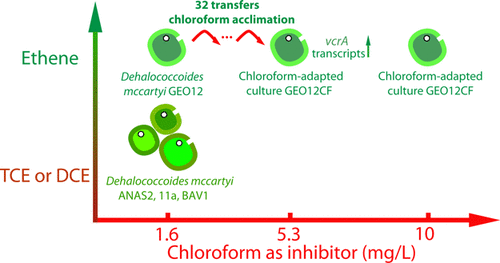当前位置:
X-MOL 学术
›
Environ. Sci. Technol.
›
论文详情
Our official English website, www.x-mol.net, welcomes your
feedback! (Note: you will need to create a separate account there.)
Dehalococcoides mccartyi Strain GEO12 Has a Natural Tolerance to Chloroform Inhibition.
Environmental Science & Technology ( IF 10.8 ) Pub Date : 2020-06-17 , DOI: 10.1021/acs.est.0c00993 Chang Ding 1 , Matthew J Rogers 1 , Jianzhong He 1
Environmental Science & Technology ( IF 10.8 ) Pub Date : 2020-06-17 , DOI: 10.1021/acs.est.0c00993 Chang Ding 1 , Matthew J Rogers 1 , Jianzhong He 1
Affiliation

|
Cocontamination by chloroform and chloroethenes often confounds bioremediation efforts. Here, we describe Dehalococcoides mccartyi strain GEO12 that dechlorinates trichloroethene to ethene in 14 μM (1.6 mg·L–1) chloroform. The same chloroform concentration effectively inhibited dechlorination in Dehalococcoides strains ANAS2, 11a, and BAV1. Successive transfers of strain GEO12 in increasing concentrations of chloroform led to culture GEO12CF that tolerated 83 μM (10 mg·L–1) chloroform. The genome of strain GEO12 revealed seven reductive dehalogenase homologous (rdh) genes, including tceA and vcrA. Transcriptional analyses showed that chloroform (45 μM; 5.3 mg·L–1) in culture GEO12CF enhanced the transcription of tceA to a statistically significant degree (the median increase was 55.4 transcripts per 104 16S rRNA, CI95% = [12.9, 125]). The increase of vcrA transcripts in the presence of chloroform (45 μM; 5.3 mg·L–1) in culture GEO12CF was not statistically significant because the CI95% range spanned 0 (the median increase was 109 transcripts per 104 16S rRNA, CI95% = [−13.6, 246]). Inhibition of dehalogenation by chloroform is often seen in Dehalococcoides, but the mechanism remains unknown. Our results suggest that culture GEO12CF may overcome chloroform inhibition by rdh upregulation. The chloroform-adapted culture GEO12CF provides insights into the metabolic flexibility of Dehalococcoides and could be used to fight chloroethene contamination where chloroform is a cocontaminant.
中文翻译:

Dehalococcoides mccartyi菌株GEO12对氯仿抑制具有天然耐受性。
氯仿和氯乙烯的共同污染经常使生物修复工作变得混乱。在这里,我们描述了Dehalococcoidesides mccartyi菌株GEO12,它在14μM(1.6 mg·L –1)氯仿中将三氯乙烯脱除为乙烯。相同的氯仿浓度可有效抑制Dehalococcoides菌株ANAS2、11a和BAV1中的脱氯。在越来越高的氯仿浓度下,菌株GEO12的连续转移导致了可耐受83μM(10 mg·L –1)氯仿的培养GEO12CF 。GEO12菌株的基因组揭示了七个还原性脱卤素酶同源(rdh)基因,包括tceA和vcrA。转录分析表明,氯仿(45μM; 5.3毫克·L -1)中培养GEO12CF增强的转录TCEA到统计学显著度(中值增加为每10 55.4转录4的16S rRNA,CI 95% = [12.9,125 ])。培养的GEO12CF中存在氯仿(45μM ; 5.3 mg·L –1)时,vcrA转录本的增加没有统计学意义,因为CI 95%范围为0(中位数增加是每10 4 16S rRNA的转录本为109个,CI 95% = [-13.6,246])。在Dehaloccocoides中经常看到氯仿对脱卤的抑制作用,但机制仍然未知。我们的结果表明,培养物GEO12CF可以克服rdh上调对氯仿的抑制作用。适应氯仿的培养物GEO12CF提供了对Dehalococcoides代谢灵活性的洞察力,可用于在氯仿是共污染物的情况下对抗氯乙烯污染。
更新日期:2020-07-21
中文翻译:

Dehalococcoides mccartyi菌株GEO12对氯仿抑制具有天然耐受性。
氯仿和氯乙烯的共同污染经常使生物修复工作变得混乱。在这里,我们描述了Dehalococcoidesides mccartyi菌株GEO12,它在14μM(1.6 mg·L –1)氯仿中将三氯乙烯脱除为乙烯。相同的氯仿浓度可有效抑制Dehalococcoides菌株ANAS2、11a和BAV1中的脱氯。在越来越高的氯仿浓度下,菌株GEO12的连续转移导致了可耐受83μM(10 mg·L –1)氯仿的培养GEO12CF 。GEO12菌株的基因组揭示了七个还原性脱卤素酶同源(rdh)基因,包括tceA和vcrA。转录分析表明,氯仿(45μM; 5.3毫克·L -1)中培养GEO12CF增强的转录TCEA到统计学显著度(中值增加为每10 55.4转录4的16S rRNA,CI 95% = [12.9,125 ])。培养的GEO12CF中存在氯仿(45μM ; 5.3 mg·L –1)时,vcrA转录本的增加没有统计学意义,因为CI 95%范围为0(中位数增加是每10 4 16S rRNA的转录本为109个,CI 95% = [-13.6,246])。在Dehaloccocoides中经常看到氯仿对脱卤的抑制作用,但机制仍然未知。我们的结果表明,培养物GEO12CF可以克服rdh上调对氯仿的抑制作用。适应氯仿的培养物GEO12CF提供了对Dehalococcoides代谢灵活性的洞察力,可用于在氯仿是共污染物的情况下对抗氯乙烯污染。










































 京公网安备 11010802027423号
京公网安备 11010802027423号